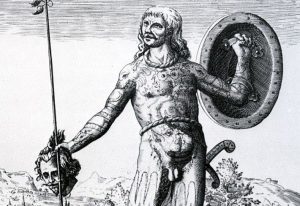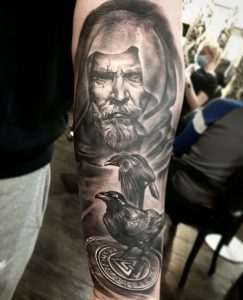A History of Tattooing in Scotland
Forgive us, but we are still geeking out on the history of tattooing in the United Kingdom. We will get back to more posts on tattooing techniques, custom made tattoos, styles, and all that jazz, but first, let’s take a look at the relationship to tattooing throughout history in Scotland.
 The Painted Ones
The Painted Ones
The country has a long history of body art, marked by passion and pride for the land, its animals and nature, and the battles fought to defend it. While many Scottish tribes are believed to have practised tattooing, the Picts (Pictii literally meaning ‘painted ones’ in Latin) were perhaps the most elaborate. According to Roman historians who wrote down and retold their encounters with these people, they were covered in pictures of animals and other figures.
In the third century CE, Herod of Antioch wrote that ‘The Britons incise on their bodies coloured pictures of animals, of which they are very proud.’ In fact, this was done with indigo ink, made from the dyer’s woad plant, part of the mustard family. Even though its flowers are yellow, the colour turns a rich bluish-green colour after it has been dried, powdered and fermented. The dye itself is also called ‘woad’.
Meanwhile, archaeological scholars at Cambridge have found that when the indigo pigment is mixed with different binders, it would turn grey-blue, through intense midnight blue, to black. No direct record exists of the exact practice or motives, and so it is difficult to say exactly what the Picts and their body art looked like.
Vikings ‘dark from their toes to their necks’
While the Picts were forming the kingdom of Alba during mid-800 CE, the Vikings began to arrive in Scotland from Scandinavia and settle in the West. Like the ancient Britons, there has been no intact frozen Viking discovered like Ötzi the Iceman to confirm that they did practice tattooing. However, just as with Roman accounts of their encounters with the Picts, there are second-hand stories from those who came across Northmen and lived to tell the tale.

In 921 CE, an Arabic scholar named Ahmed Iban Fadlan came across Vikings while travelling along the Volga River in modern-day Russia. Following the encounter, he described the tall people as covered in images of trees and other pictures.
‘As tall as palm trees, fair and reddish, they wear neither tunics nor caftans. Every man wears a cloak with which he covers half of his body so that one arm is uncovered. They carry axes, swords and daggers and always have them to hand. They use Frankish swords with broad, ridged blades. They are dark from the tips of their toes right up to their necks – trees, pictures, and the like.’
What would they have been adorned with? Well, God of War 3 and the hit TV show Vikings may not be far off. Most likely, they would have had symbols of protection, such as wards against bad weather or motives to inspire fierceness in battle. The trees of which Fadlan spoke may well be representations of Yggdrasil, the tree of life in Norse mythology. Or perhaps the Vikings were inspired by the Picts and their images of nature.
